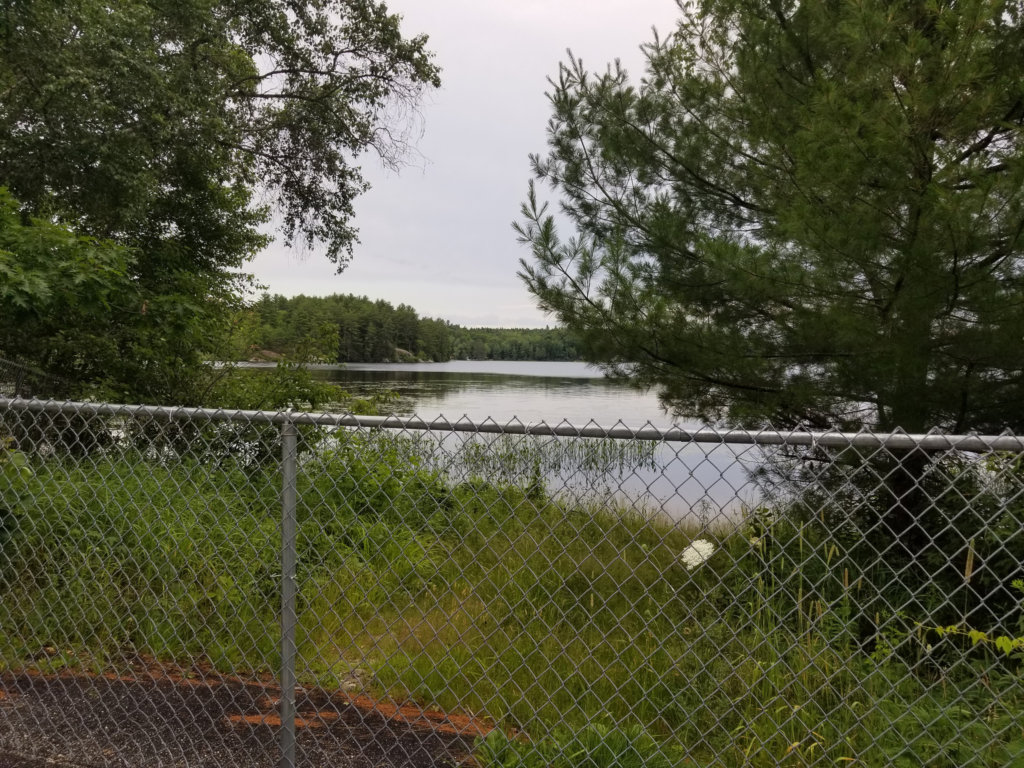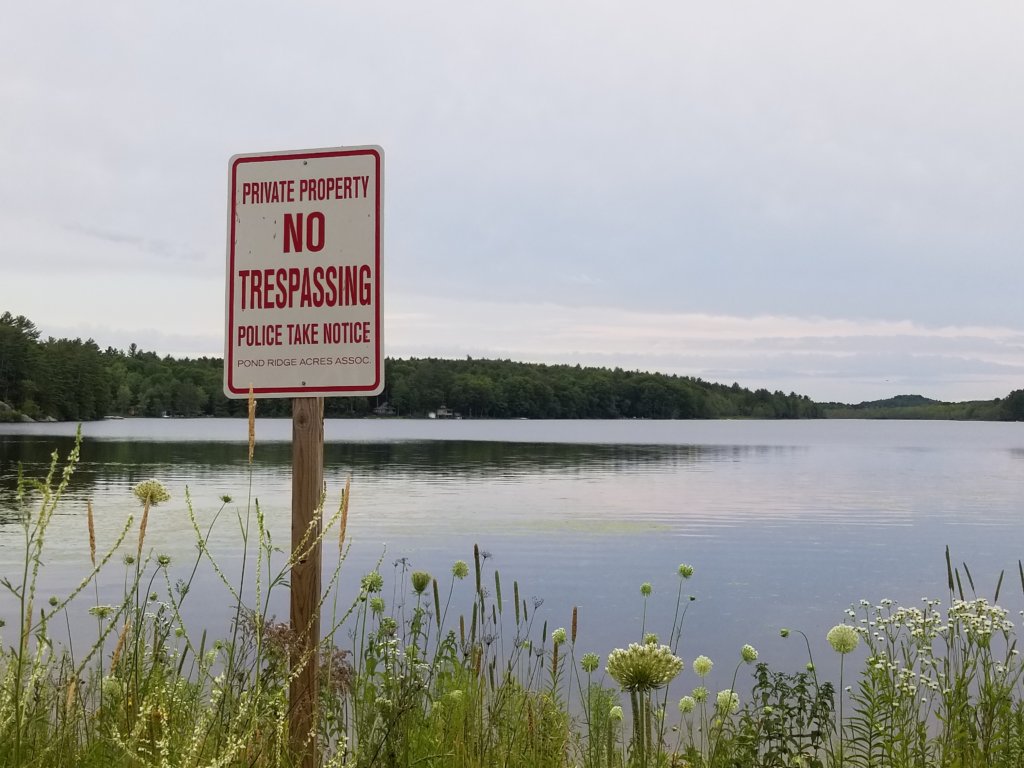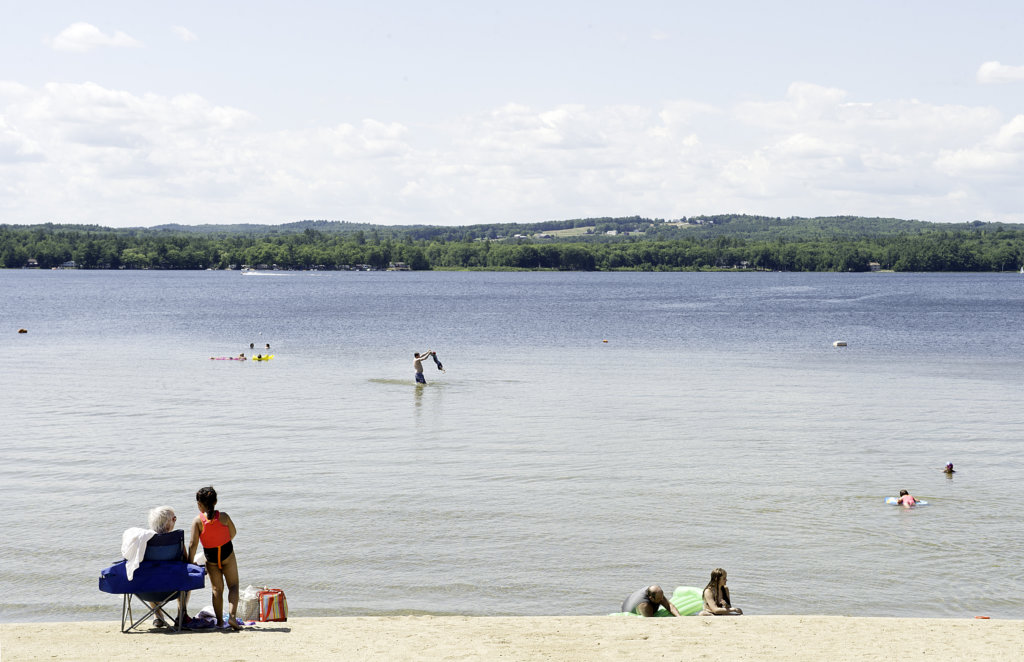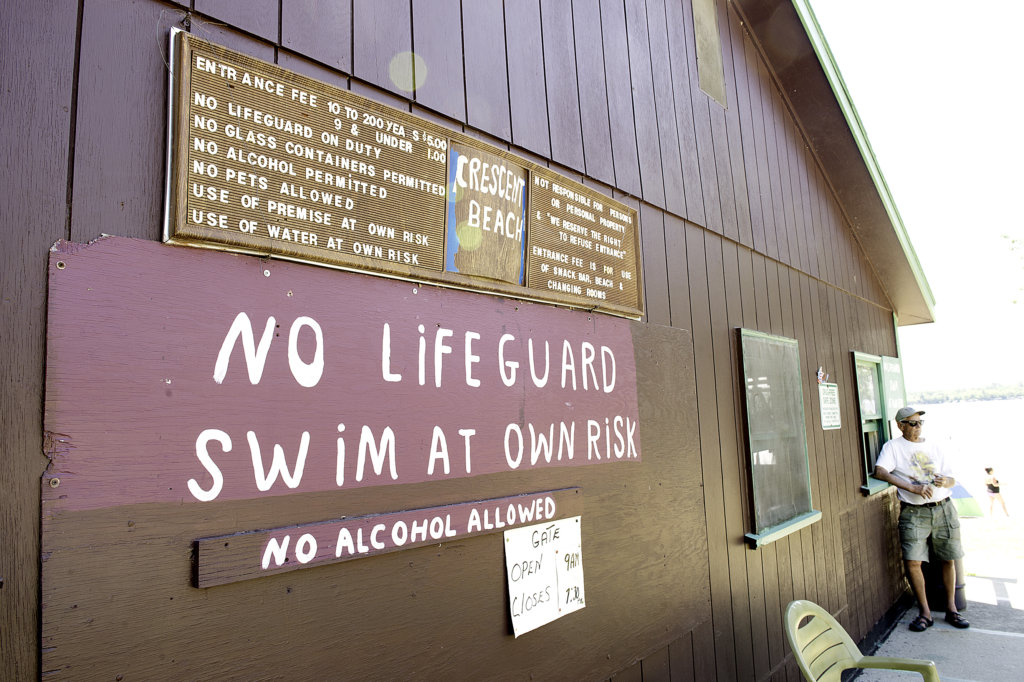Scattered through Maine’s real estate listings are all sorts of paeans to the glories of living on the shore of one of the state’s more than 6,000 lakes.
From sunsets to snowmobiles, fishing to frolicking, sellers make it clear that anyone with enough cash to claim or create a waterfront camp can experience the way life ought to be.
For those with the means, it may prove true.
But for others, the steady growth around Maine’s lakes — especially smaller ones not too far from urban areas — has made it more difficult to share the experience. With every passing year, there are fewer places for everyday Mainers to take a dip or put a canoe in the water.
Even so, “the vast majority” of Maine’s lakes remain unusually accessible to the public, including many with boat launches and beaches, said Colin Holme, executive director of the Lakes Environmental Association in Bridgton.
“Maine has done a really good job of making sure that people have access to these beautiful resources,” Holme said, especially compared to the paltry efforts in southern New England.
“We’re pretty lucky here,” Holme said.
Though few would argue about Maine’s good fortune, it’s also true that a slow-motion change has turned some lakes that Mainers once used for fishing, cutting ice and a whole realm of activities into private preserves for those with the means to access them.
It’s an issue that hits close to home in Lewiston, where No Name Pond is essentially off limits, and in Auburn, where the same is true of Taylor Pond, one of the largest in Maine without any clear public access.
The state noted the problem almost a quarter-century ago in a report that successfully sought to spur greater effort to provide venues to reach the lakes — especially because a colonial-era law says all Maine lakes that cover more than 10 acres are themselves public property.
“When the public cannot gain access to waters used freely by shorefront owners, the public interest is not well-served,” the state report said. “Everyone should have equitable access to public resources regardless of their income or residency.”
Most of the time, as a recent flap about the closure of a beach on Sabbathday Pond in New Gloucester demonstrated, this gradual limiting of access has occurred as new homes have gone up — along with fences and gated roads — in spots where the public traditionally reached the water.
The law guarantees the public’s right to traverse any unimproved land beside a “great pond” — the term used for Maine’s 10-acre-plus waters — to access them, but that unimproved land is slowly disappearing.
Because owning property on the water — or even renting it — has become so costly, many Mainers “will not be able to enjoy the state’s waters unless public access is provided,” the 1995 report concluded.
In the years since, the state has added more boat launches and locked in more public access in spots, but old-time methods of reaching Maine’s freshwater lakes — about 2,600 are big enough to count as public property — continue to fade away.
“It’s unfortunate that we’re losing more and more of that public access every year,” said state Rep. Gary Hilliard, R-Belgrade.
It’s not a rapid shift, several officials said, and it’s not considered a crisis. No one interviewed worried that access to Maine’s lakes in the future will be gone. There are state and local parks and 575 known boat launches statewide, with more to come. But there is also an ever-growing list of spots where Mainers once could go with ease, where they now can’t go at all.
ONE EXAMPLE: SABBATHDAY LAKE
Stand beside the old Grange hall at one end of the 342-acre Sabbathday Lake in New Gloucester and the view can be breathtaking.
One hot summer day recently, a great blue heron circled briefly overhead while a light breeze rippled the surface of the sparkling water. Trees lined the shore in every direction.
Off in the distance, a boat whizzed along. Closer to shore, a teenager lounged in a big yellow float, soaking in the sun. Two kayakers paddled back toward the far-off outlet.
Who wouldn’t find something to relish in that scene?
For generations, people in the area gathered at a small beach in front of the Grange hall to swim or put a little boat in the water or just take it all in.
That’s all over now.
A developer fenced off the beach recently, determined to make it the private preserve of whomever buys seven lots in the Sabbathday Shores subdivision he’s creating beside the Grange hall.
The land is private property, and the developer who owns it has every right to fence it off. But his actions have eliminated already rare public access to the lake.
“They’ve shut everybody out of the lake,” resident Eric Purcell said, except those who live alongside it.
A real estate broker who grew up in the New Gloucester area, Matt Trudel, said the problem for property owners, including the developer, is that too many people misuse sites that are open.
He said that when landowners find needles, diapers, toilet paper and other debris, they aren’t eager to make their land available. “That’s when they block it,” he said.
“Some bad apples ruin it for everybody,” said Trudel, who’s trying to sell the lots in the Sabbathday Shores subdivision.
No doubt the concerns are valid. Even Purcell agreed the spot attracted some “bad apples” at times.
Trudel said plenty of people are unhappy with the property’s changed status.
When the fence posts were going in, he said, somebody yanked them out and threw them in the lake.
Now, though, the fence is up, the beach is clean and the public is stuck watching from the road.
Unless they own a site beside the lake — or get the go-ahead from someone who does — the only public access left is through the privately owned Outlet Beach at the other end of the lake, which is also a nice spot.
However, during the summer season, Outlet Beach’s property owner collects a fee.
The lost access at Sabbathday Pond is perhaps no big deal in the big picture, but it’s part of a trend that appears to undermine both public policy and Maine’s historical ties to its many waters.

MAINE’S GREAT PONDS LAW
One of the oddities of Maine is that the significant inland bodies of water are public property, even if every lot alongside them is privately owned.
Maine and Massachusetts share a legal heritage that offers a unique right to access what they call “great ponds.”
Back in 1647, the Massachusetts Bay Colony passed a law ensuring that lakes of 10 acres or more belonged to the public, not adjoining landowners. It also said that people “shall not be denied access or egress over unimproved land” to reach the water.
The law eventually became the norm for all of Massachusetts, which at the time included Maine. When Maine became a separate state nearly two centuries ago, the law remained on its books as well. It applies to about 2,600 lakes. More than 1,600 of them encompass at least 30 acres. There are 176 that top 1,000 acres.
As one Maine court put it in 1891 — a time before refrigerators, when lawsuits about who could cut the ice on state lakes and rivers were common — the public’s ownership meant people had “the rights of fishing, bathing and boating therein, and of taking ice.”
A 1910 decision said people could “fish and fowl and to cut ice” provided they could reach the pond “by passing to it on foot without trespassing upon any man’s corn or meadow.”
The last time the Legislature codified the old common law, in 1973, it said that “no person on foot shall be denied access or egress over unimproved land to a great pond,” except sometimes those used for public water.
Great ponds are defined as any natural body of water of more than 10 acres and artificial ones, created by a dam, of more than 30 acres.
The social value of the 2,600 or so great ponds that qualify is laid out in a 1991 statute that declares, “Maine’s great ponds are an important element of the state’s economy and traditional way of life.”
“Their abundance and relatively high water quality are precious resources in light of the growing inadequacy of water supplies and the deterioration of natural settings and habitat in many other states. The use of great ponds as a source for drinking water, recreation and power production is vital to the state,” the law said.
In a broad sense, the courts and the law “encourage a policy of promoting public access to the outdoors by opening private land to the public,” according to a 2016 Maine Law Review article.
NEW LAUNCHES, LAND TRUSTS ADD ACCESS
Despite the public policy, scores of Maine lakes are now surrounded by private property, with no easy access.
In Androscoggin County alone, there are six great ponds with no easy public access, including No Name Pond, which covers 111 acres, and the 653-acre Taylor Pond in Auburn.
The state has long taken notice of the problem, starting more than half-a-century ago to create sites where residents and visitors could put their boats into the water, something critical for those interested in fishing.
“Access is a huge thing,” said Mark Latti, spokesman for the Department of Inland Fisheries and Wildlife.
Latti said access to private land is critical in Maine, where more than 90 percent of the land is not government-owned. It matters for fishing, hunting and more, he said, so it’s an issue the state tries to work on.
Jen Jespersen, president of the Maine Lakes Society, said her impression is that there is a lot of “good public access” in much of the state and more on the way.
She cited two places, in Mount Vernon and Wilton, where the state is helping put new launches in that will make access better.
George Smith, one of Maine’s top outdoors writers, said he hasn’t seen a real problem with accessing Maine’s lakes, in part because there’s so much water available.
But, he said, “people have their special places” and they can be vulnerable to development.
“It isn’t the totality of it,” Smith said. It’s the particulars of a given situation, he said.
Smith said a bigger, but related, concern is that too many of the state’s ponds and lakes don’t have any sort of launch area. He said he’d like to see an organized effort to press for more.
Colin Brown, education and outreach manager for the Downeast Lakes Land Trust in Grand Lake Stream, said land trusts, an increasingly critical part of the landscape in Maine, are actually making boat access to lakes more common as they seek to conserve property for the future.
Access “is definitely not in decline” from what he’s seen in northern Maine, but Brown acknowledged the situation may differ in more populated parts of the state.
Among land trusts, Brown said, “there’s been a real resurgence about providing public boat access sites” because conservation-minded people realize that for Mainers and visitors alike, access to the state’s “beautiful natural resources” is vital.
If there’s any solid data on the loss of public access, it has proven elusive. For some observers, it’s just an impression, often vague and halting, that something’s not quite right.
Thomas Linscott, boating facilities director for the Department of Agriculture, Conservation and Forestry’s Bureau of Parks and Lands, said he had heard of private sites that are no longer available to the public, but he had no information on how widespread the problem is.
“It definitely is a concern,” he said, but he doubts traditional access points are disappearing quickly.
Latti said it is “hard to measure” access in a general way, in part because “Maine’s landscape is changing all the time” with property shifting hands frequently.
Latti said situations like the one at Sabbathday Lake “happen more than we think” because they are rarely publicized.
He said that with about 400 state-owned boat launches for 6,000 lakes and 30,000 miles of rivers “it doesn’t add up” well for good access to many spots.
One issue Linscott has noticed is that some fish and game clubs that once provided ready access “seem to be slowly going out of existence.”
In other cases, he said, new owners have closed off points that previous ones left open for the public.
That 1995 report, which helped spur the creation of more launch sites on Maine’s waterways, lays out the case.
“For generations, numerous shore landowners have allowed the public to cross their property to launch boats and fish from the shore,” it said. “Often these sites are small and informal, yet taken as a whole, they are important to providing access and dispersing recreational opportunities throughout the state.”
“In the last few decades, however, many informal access sites, especially those near population concentrations, have been eliminated by seasonal or year-round homes, or closed to public use in anticipation of development or because of new ownership philosophy,” the report by two state departments said.
Pointing to lost access points on East Pond in Smithfield and Square Pond in Acton, it called the trend “especially disturbing because waterfront land for public purchase to replace lost sites is becoming increasingly scarce and costly.”
At the same time people began to find it more difficult to rely on traditional access points, they found themselves priced out of increasingly costly shoreline property they might once have purchased for themselves, the study said.
Some of the lakes “don’t have any access” for the public, including “some very well-developed” places, Linscott said. If properties beside them become available, though, it may be possible to take steps in the future to make them accessible.
The study said its target for adding new boat-launch sites, ranging from carry-in points on the shore to full-blown paved areas with parking, would help substantially.
Even so, it said, it “will not be enough to keep pace with the continued loss of traditional access and increased demand.”
Most officials said that’s still true today.

TRASH, NEEDLES AND USED DIAPERS = CLOSED
It doesn’t take many dirty diapers or piles of used toilet paper to make a property owner wonder about the wisdom of letting strangers come and go.
At Sabbathday Pond, the developer filled up dozens of garbage bags when he cleaned things up after the fence was erected this spring.
As the town’s code enforcement officer, Debra Parks Larrivee, watched one day, she saw diapers floating in the water.
Linscott said it doesn’t help secure access to the water when littering and other problems at some public sites have marred relations with some neighbors.
When Lewiston gave up on helping the public access No Name Pond in 2014, officials cited trash as a big reason, and the lack of a public toilet, which added to the unsavoriness of the situation.
People “were leaving trash behind and other things you can only imagine. It was pretty offensive, it was a public health concern and, in some cases, a water quality concern,” Phil Nadeau, the city’s former deputy administrator, said at the time.
The willingness to allow public access may also go beyond the practical to something more philosophical. Linscott said new owners of lakefront property “may not be as open to the practices of the past” as older ones were.
Several law review pieces suggest that courts and citizens alike are simply more prone to think of their property as entirely their own — something they can freely exclude people from crossing.
The law itself hasn’t changed over the centuries, but the community has.
One option: Taxpayers can authorize their municipalities to buy land beside lakes to ensure easy public access.
Even that, though, can be tough.
Back in 2013, for example, the town of China sought to address what it called one of its top priorities: securing public access to China Lake for swimming and a second boat launch. After studying options, officials sought to buy 9 acres on gradually sloping land that led to the water.
Worried about the expense, the town’s voters overwhelmingly gunned down the plan.
One of the opponents, 34-year-old Melissa Tenney, told the Kennebec Journal, “I’d prefer not to pay additional taxes to spend one or two days a year at the property. I pay enough taxes, and if I want to take my two kids to a beach, I don’t mind driving somewhere and paying for it once.”
In New Gloucester, Purcell said he doesn’t mind too much driving elsewhere to get on the water after the closure of his favorite spot on Sabbathday Lake.
But, he said, for a lot of others who used the once-public land, paying to go to a private beach or public park isn’t possible. They just don’t have the money, Purcell said.
HOW TO GET ON THE WATER IN MAINE
There are still thousands of spots where people can reach the shores of Maine’s abundant lakes. For every one that’s closed off, a few are still open, some of them with a little difficulty and others with no trouble at all.
Across Maine, there are parks, beaches, boat launches and more where the public can go for free or for a small fee.
Some areas have more opportunities than others.
Hilliard, who lived on Long Pond for years, said his Belgrade Lakes region has so many lakes that the ability to reach the water somewhere hasn’t been a major issue.
“We’re in kind of a good situation around here,” he said.
Where there aren’t launches, many bodies of water are accessible by carrying in a small boat, Smith said, sometimes through private property that’s posted against trespassing.
“We can walk through anybody’s property, even if it’s posted,” Smith said, because access is guaranteed through undeveloped land.
That’s not enough for many people.
Linscott said there are bodies of water “where we’d like to secure more access.”
There’s a priority list, he said, that officials compiled in consultation with biologists and other experts to try to increase access in the future.
Linscott said state-owned sites and most of the launches the state helped fund will remain available to the public in perpetuity.
The state develops its own launches when it can, but it also helps municipalities, clubs and companies create sites, sometimes with grants, other times with equipment. Its list of sites is on a Google map available online.
In any case, take comfort from the experience of Steve Chaisson, a retired Maine guide who lives mostly in Florida now.
He said it’s quite different fishing in Florida.
Public access isn’t the big problem there.
“It’s ‘gators,” he said.

Access to Androscoggin County lakes
In Androscoggin County, there are at least 31 lakes and ponds large enough to qualify as public property under the state’s “great ponds” law.
At least six of them have no public access, according to information gathered by the Department of Inland Fisheries and Wildlife.
In three cases, it says obtaining property to allow for boat access is a department priority.
The largest one without access in the county is Taylor Pond in Auburn.
The department says access to it “is available only by permissive trespass.” It said that purchasing and developing public access to it is a priority.
There is also “a need to acquire permanent public boat access” to Lewiston’s No Name Pond, it said.
The state would also like “a more suitable public boat access” to the 183-acre Allen Pond in Greene.
Ponds with no listed public access in the county include Berry Pond in Greene, Lard Pond in Turner, Nelson Pond in Livermore, and Little Wilson Pond on the border of Turner and Auburn.

Learn more about lake access online
Maine is chock full of both lakes and boat launch sites.
To get a sense of where the lakes are, check out an online map of Maine’s lakes that are 10 acres or larger that is based on state data. They are known as “great ponds” and belong to the public, no matter who lives beside them.
In every case, the law allows access to them through undeveloped land, even it is posted against trespassing. It’s still best to ask permission, however, out of courtesy if nothing else.
Some of the lakes and most of the rivers offer sites to launch boats. Using data from the state, the Sun Journal prepared an online map of Maine’s boat launch sites.
The launch sites vary widely in quality. Some are quite small and designed to put only carry-in boats in the water, but many can handle larger ones. It’s best to check on details before traveling any distance, since situations can change.
George Smith, one of Maine’s best-regarded outdoors writers, said last week that low water levels are making access difficult at some launches this summer.
Comments are no longer available on this story